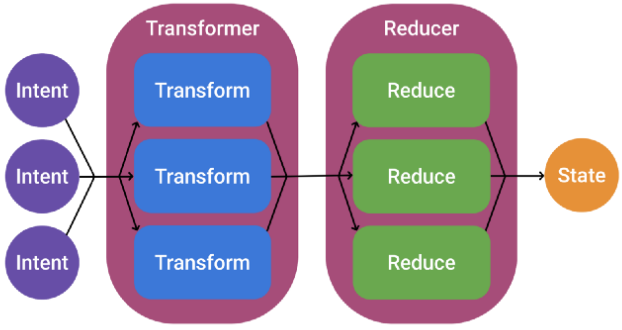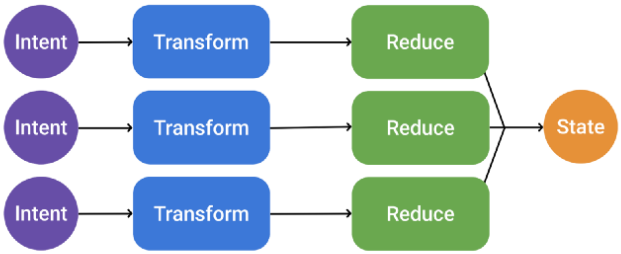Motivation
In A Matter of Taste we discussed two different styles to define reducers (catch-all vs single-action reducers). In this chapter we take the idea of single-action reducers one step further. To recap, this is what we have so far:
bloc<Int, Action>(context, 1) {
reduce<Increment> { state + 1 }
reduce<Decrement> { state - 1 }
// vs.
reduce {
when(action) {
is Increment -> state + 1
else -> state -1
}
}
}
The idea of BlocOwners was inspired by the Orbit framework which has the concept of a ContainerHost used for classes that want to launch Orbit intents. Here's an example:
class CalculatorViewModel: ContainerHost<CalculatorState, CalculatorSideEffect>, ViewModel() {
override val container = container<CalculatorState, CalculatorSideEffect>(CalculatorState())
fun add(number: Int) = intent {
postSideEffect(CalculatorSideEffect.Toast("Adding $number to ${state.total}!"))
reduce {
state.copy(total = state.total + number)
}
}
}
The ContainerHost concept is an iteration over the MVI model, enabling us to define the intent / business logic wherever we want. The author of the framework compares the Redux style vs. the MVVM+ style (that's what he calls the Orbit approach) of implementing MVI in this article. The following two diagrams summarize the two styles nicely.
Redux Style

Intents are represented by objects, piped through a stream into a transformer and reducer, which produces a single state output.
MVVM+ Style

Intents here have their own transformer and reducer (a function) before being combined into the single state output.
BlocOwner
A BlocOwner in Kotlin Bloc is the equivalent of an Orbit ContainerHost. It's an interface that can be implemented by any class and has a Bloc:
public interface BlocOwner<out State : Any, in Action : Any, SideEffect : Any, Proposal : Any> {
public val bloc: Bloc<State, Action, SideEffect>
}
Extension functions give the BlocOwner the "power" to define initializers, reducers, thunks and side effects. The syntax is even simpler than with Orbit (which requires to wrap everything in an intent statement before reduce, postSideEffect and repeatOnSubscription can be used):
class PostListViewModel(context: ActivityBlocContext) : ViewModel(),
BlocOwner<PostsState, Nothing, Posts.OpenPost, PostsState>,
KoinComponent {
private val repository = getKoinInstance<PostRepository>()
override val bloc = bloc<PostsState, Nothing, Posts.OpenPost, PostsState>(
blocContext(context),
blocState(PostsState())
) {
// note: an initializer needs to be defined in the bloc because it can't transition
// to Started state if it doesn't know if and when an initializer is submitted
// (no MVVM+ style initializers!)
onCreate {
if (state.isEmpty()) {
loading()
loaded(repository.getOverviews())
}
}
}
private fun loading() = reduce {
state.copy(loading = true)
}
private fun loaded(posts: List<Post>) = reduce {
state.copy(loading = false, posts = posts)
}
fun onPostClicked(post: Post) = sideEffect {
Posts.OpenPost(post)
}
}
In above example an Android ViewModel implements the BlocOwner interface but any class can implement it to use the "MVVM+ syntax". As a matter of fact with Extensions, you could put the business logic into an Android Activity and still retain state across configuration changes (of course you'd do that only for simple applications):
class CounterActivity : AppCompatActivity(), BlocOwner<Int, Int, Unit, Int> {
override val bloc by getOrCreate { bloc<Int, Int>(it, 1) }
private fun increment() = reduce { state + 1 }
private fun decrement() = reduce { state - 1 }
override fun onCreate(savedInstanceState: Bundle?) {
setContent {
val state by bloc.observeState()
// here goes the view declaration
}
}
Reducers are always processed sequentially regardless whether they were triggered by an action (Redux style) or by a function (MVVM+ style). See also Concurrency.